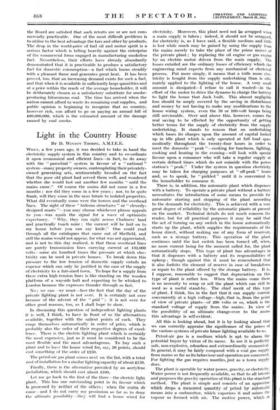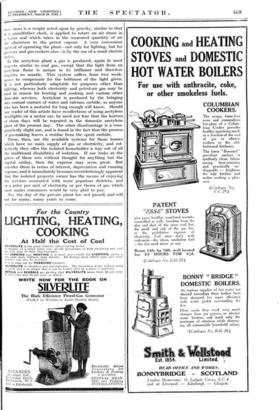Light in the Country House By D. WINTON THORPE, A.M.I.E.E.
WHEN, a few years ago, it was decided to take in hand the electricity supply system in this country • and to co-ordinate it upon economical and efficient lines—in 'fact, to do away with the " parochial " system in favour of a " national " system—many property owners, contemplating their privately- owned generating sets, sentimentally brooded on th6 fact that the poor old plant had served them well, and wondered whether she would last out another few months " until the mains came." Of course the mains did not come in a few months ; nor did they come in a few years ; nor, to be quite frank, will they come in the near future to isolated properties. What did eventually come were the towers and the overhead lines. The sight -of these " hideous structures " or " cleverly- designed masts "—you may choose whichever phrase appeals to you—was again the signal for a wave of optimistic expectancy. " Why, they run right across Chalmers' land and practically touch mine ; the current will be laid on to my house before you can say knife." One could read through all the catalogues that came out of Sheffield, and still the mains would not appear, for what was not appreciated, and is not to this day realized, is that these overhead lines are purely transmission lines carrying current at 132,000 volts—some six hundred times the pressure at which elec- tricity can be used in private houses. To break down this pressure to the low tension of domestic supply entails an expense which can only be justified in the case of the supply of electricity to a fair-sized town. To hope for a supply from these extra high tension lines is like standing on the wooden platform of a wayside halt and expecting to be whisked to London because the expresses thunder through so fast.
No ; we can—we must—face the fact that the day of the private lighting plant is not over. It is certainly not over because of the advent of the " grid " ; it is not over for other good reasons, too, as I shall hope to show.
In discussing this question of independent lighting plants it is well, I think, to have in front of us the alternatives available, together with the salient points of each. They range themselves automatically in order of price, which is probably also the order of their respective degrees of excel- lence. There is the electric lighting plant which is certainly the most expensive, just as it must be considered to be the most flexible and the most advantageous. To buy such a plant and to have the house wired for, say, 50 points, should cost something of the order of £250.
The petrol-air gas plant comes next on the list, with a total cost of installation for a similar lighting capacity of about £150.
Finally, there is the alternative provided by an acetylene installation, .which should cost about £100.
Let me go back to the first of the three—the electric light plant. This has one outstanding point in its favour which
3s possessed by neither of the others ; when the mains do come—and I do not carry my pessimism so far as to deny the ultimate possibility—they will find a house wired for electricity. Moreover, this plant need not be scrapped when a main supply is taken ; indeed, it should not be scrapped,
for electricity is, as I have said, a flexible medium and little is lost while much may be gained by using the supply from the mains merely to take the place of the prime mover of the private plant ; by replacing the oil engine or gas engine by an electric motor driven from the main supply. The losses entailed are the ordinary losses of efficiency which the engineering mind expects from any mechanical or electrical process. Put more simply, it means that a trifle more elec- tricity is bought from the supply undertaking than is ulti- mately applied to the lighting of the house. A very small amount is dissipated—I refuse to call it wasted—in the effort of the motor to drive the dynamo to charge the battery to light the house that Jack built. This almost negligible loss should be amply covered by the saving in disturbance and money by not having to make any modifications to the house wiring system, even the 50 or 100-volt lamps being still serviceable. Over and above this, however, comes the real saving to be effected by the opportunity of getting better terms for the supply of electricity from the supply undertaking. It stands to reason that an undertaking which bases its charges upon the amount of capital locked up in idle plant which is only operated at full load spas- modically throughout the twenty-four hours in order to meet the domestic " peak "—cooking for luncheon, lighting, cooking and heating in the evening—will look with special favour upon a consumer who will take a regular supply at certain defined times which do not coincide with the power station's " peak." Under the system in question electricity may be taken for charging purposes at " off-peak " hours and, so to speak, be pickled " until it is convenient to the householder to consume it.
There is, in addition, the automatic plant which dispenses with a battery. To operate a private plant without a battery necessitates the introduction of some means to provide for automatic starting and stopping of the plant according to the demands for electricity. This is achieved with a very great degree of reliability by the automatic plants at present
on the market. Technical details do not much concern the reader, but for all practical purposes it may -be said that
the act of turning on any switch in the house automatically starts up the plant, which supplies the requirements of the house direct, without making use of any form of reservoir, such as a storage battery. This operation of the plant continues until the last switch has been turned off, when, no more current being for the moment called for, the plant automatically stops. This type of plant has advantages in that it dispenses with a battery and its responsibilities of upkeep ; though against this it must be remembered that it also forfeits the element of reserve in case of breakdown or repair to the plant offered by the storage battery. It is, I suppose, reasonable to suggest that depreciation on this type of plant is rather less. When the mains come there is no necessity to scrap or sell the plant which can still be used as a useful stand-by. The chief merit of this type of plant, I think, lies in the fact that it can supply current conveniently at a high voltage—high, that is, from the point of view of private plants—of 200 volts or so, which is the standard voltage of supply from the mains. In view of the possibility of an ultimate change-over to the mains this advantage is self-evident.
All this is looking ahead, but it is by looking ahead that we can correctly appraise the significance of the prices of the various systems of private house lighting available to us. Petrol-air gas is a medium which is apt to alarm the potential buyer by virtue of its name. In use it is perfectly safe, non-explosive, odourless and extraordinarily economical. In general, it may- be fairly compared with a coal gas supply from mains so far as its behaviourand operation are concerned. For lighting the gas requires mantles, just as a town supply does.
The plant is operable by water power, gravity, or electricity, Water power is not frequently available, so that to all intents and purposes the gravity operation of this plant is the standard
method. The plant is simple and consists of an apparatus which- drops a -measured quantity of petrol by automatic
means into a carburettor, which vaporizes it and mixes the vapour so formed with air. The motive power, which in
most cases is a weight-acted upon by gravity, similar to that in a grandfather clock, is applied to rotate an air drum in a water seal which takes in the measured quantity of air for admixture to the petrol vapour. A very convenient method of operating the plant—not only for lighting, but for gas-fires and gas-cookers also—is by the use of a small electric motor.
In the acetylene plant a gas is produced, again in most respects similar to coal gas, except that the light from an acetylene flame is unique in its brilliance and therefore requires no mantle. This system suffers from two weak- nesses to compensate for the brilliance of the light given. It is not particularly adaptable for purposes other than lighting, whereas both electricity and petrol-air gas may be used in reason for heating and cooking and various other domestic services. Acetylene is produced by the bringing into mutual contact of water and calcium carbide, as anyone who has been a motorist for long enough will know. Should any reader of this article have recollections of using acetylene headlights on a motor car, he need not fear that the horrors of those days will be repeated in the domestic acetylene plant of the present day. The other disadvantage is a com- paratively slight one, and is found in the fact that the process of gas-making leaves a residue from the spent carbide.
These, then, are the available systems for those houses which have no main supply of gas or electricity, and col- lectively they offer the isolated householder a way out of all the traditional disabilities of isolation. If one looks at the prices of these sets without thought for anything but the capital outlay, then the expense may seem great. But consider them in terms of interest, depreciation and running expense, and it immediately becomes overwhelmingly apparent that the isolated property owner has the means of enjoying the services associated with more populous districts, and at a price per unit of electricity or per therm of gas which most mains consumers would be very glad to pay.
No; the day of the private plant has not passed, and will not for many, many years to come.



















































 Previous page
Previous page